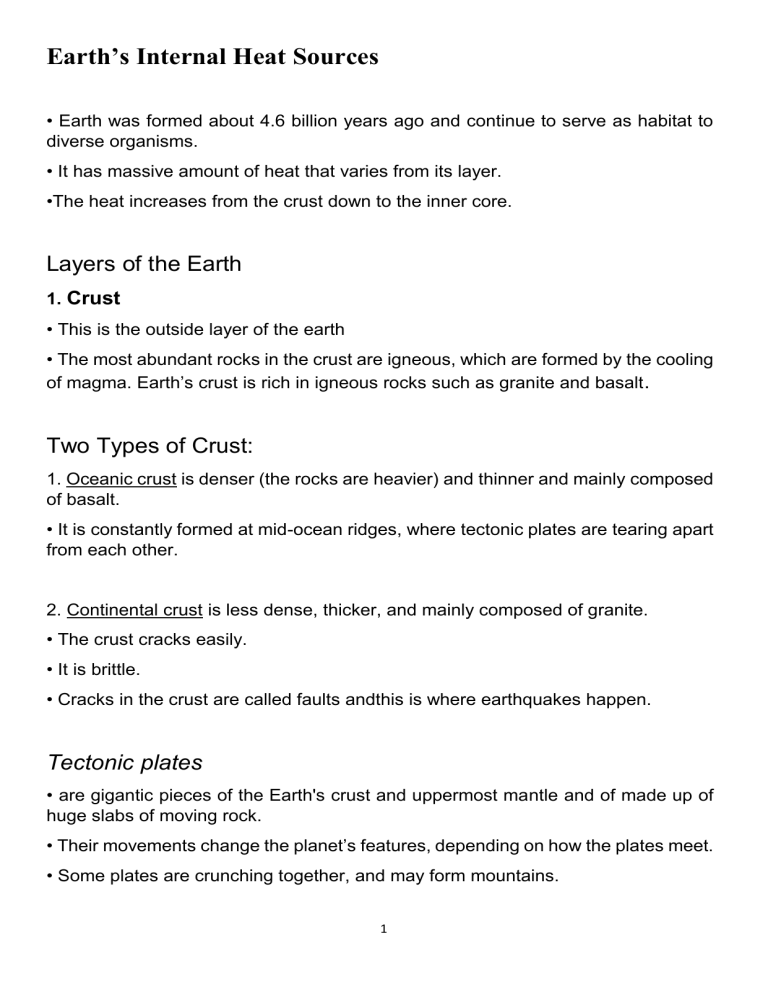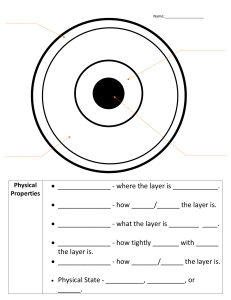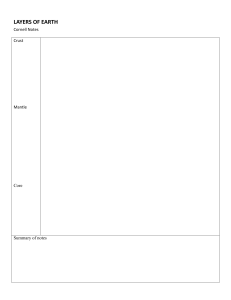Earth's Internal Heat: Sources, Layers & Transfer Processes
advertisement

Earth’s Internal Heat Sources • Earth was formed about 4.6 billion years ago and continue to serve as habitat to diverse organisms. • It has massive amount of heat that varies from its layer. •The heat increases from the crust down to the inner core. Layers of the Earth 1. Crust • This is the outside layer of the earth • The most abundant rocks in the crust are igneous, which are formed by the cooling of magma. Earth’s crust is rich in igneous rocks such as granite and basalt . Two Types of Crust: 1. Oceanic crust is denser (the rocks are heavier) and thinner and mainly composed of basalt. • It is constantly formed at mid-ocean ridges, where tectonic plates are tearing apart from each other. 2. Continental crust is less dense, thicker, and mainly composed of granite. • The crust cracks easily. • It is brittle. • Cracks in the crust are called faults andthis is where earthquakes happen. Tectonic plates • are gigantic pieces of the Earth's crust and uppermost mantle and of made up of huge slabs of moving rock. • Their movements change the planet’s features, depending on how the plates meet. • Some plates are crunching together, and may form mountains. 1 • Others are splitting apart. When this occurs under ocean floor, it creates new ocean floor. • Some plates gring past each other. These are th emost most likely to cause earthquakes. 2. Mantle • The Mantle is the largest layer of the earth with estimated 1800miles thick. • The mantle is the mostly-solid bulk of Earth’s interior but punctuated by malleable areas of semi-solid magma. • The mantle lies between Earth’s dense, super- heated core and its thin outer layer, the crust. •The rocks that make up Earth’s mantle are mostly silicates—a wide variety of compounds that share a silicon and oxygen structure. • Movement in the mantle caused by variations in heat from the core, cause the plates to shift, which can cause earthquakes and volcanic eruptions. • These natural hazards then change our landscape, and in some cases, threaten lives and property. 3. Core • Is composed of liquefied metals such as nickel and iron. • It is kept in its liquefied state because of the immense heat in this layer. The core is the centre of the earth and is made up of two parts: a. the liquid outer core b. solid inner core. Inner Core •It is the centre and the hottest layer of the Earth. •The inner core is solid and made up of iron and nickel. •Due to its immense heat energy, the inner core is more like the engine room of the Earth. 2 •It is believed that the temperature and pressure at depth is so great that the metals are squeezed tightly together restricting movement, so much that the particles have to vibrated in place almost like a solid structure. Outer Core • The outer core of the Earth is similar to a very hot ball of metals • It is so hot that the metals inside are all liquid. Heat is needed in order for organisms to survive. •The Earth's internal heat provides the heat and energy which supplies the force for natural phenomena such as earthquakes and volcanic eruptions. It also provides energy for the movement of the plates. •However, despite the large amount of heat that the Earth possesses, its internal energy is greater during its early stages. 2 categories of heat in Earth’s Interior 1. Primordial Heat 2. Radioactive Heat Earth’s Internal Heat Source Earth was formed about 4.6 billion years ago and continue to serve as habitat to diverse organisms. Its biotic components remain alive due to proper regulation of internal heat. It has massive amount of heat that varies from its layer. 3 • The heat increases from the crust down to the inner core due to several reasons. • This internal heat comes from the following sources. 1. Primordial heat •Primordial (means from the beginning of time) heat left over from the earth’s formation-meteorite collisions. •The Earth was formed from the process of accretion wherein gasses and dust of cloud was attracted by gravitational energy. • In the process, due to the collision of these masses, heat was generated. This process formed the earliest stage of planet Earth which is molten in state and heat is trapped in the core of the planet. • There had been the convective transport of heat within the core to the mantle of the earth. • While conductive transport of heat occurs through different plate boundary layers. 2. Radiogenic• Earth is considered as thermal engine since its main source of internal heat come from the produced decay of some naturally occurring isotopes from its interior. • This process is known as radioactive decay by which the spontaneous breakdown of an atomic nucleus causes the release of energy and matter from the nucleus. • heat produced by the radioactive decay of isotopes, particularly Uranium, Thorium and Potassium •This process of radioactive decay which emits heat energy as one of the products prevents the Earth from completely cooling off. 4 Process of Heat Transfer 1. Conduction• the process by which heat energy is transmitted through collisions between neighboring atoms or molecules. • heat flows from warmer objects to cooler objects •The lower mantle is heated directly by conduction from the core. •In conduction, heat is transferred as atoms collide. 2. Convection •is the transfer of heat energy in a fluid and it is a more effective mode of heat transport in the Earth than pure conduction. •heat transport in the fluid outer core and the mantle. • Convection is the process by which heat is transferred from a solid surface to a nonsolid, such as air or water. •The convection process involves the motion of the fluid relative to the solid surface and the processes by which heat is transferred across the interface. • Although the surface of the Earth is solid, its interior is soft and flows like a very viscous fluid. • This flow, called mantle convection, is an important method of heat transport within the Earth. • Mantle convection is the driving mechanism for plate tectonics, which is the process ultimately responsible for producing earthquakes, mountain ranges, and volcanos on Earth. • Through the process of conduction, heat flows from warmer objects to cooler objects. • The lower mantle is heated directly by conduction from the core. In conduction, heat is transferred as atoms collide. • Hot lower mantle material rises upward. As it rises, it cools. At the top of the mantle, it moves horizontally. • Over time it becomes cool and dense enough that it sinks. Back at the bottom of the mantle, it travels horizontally. Eventually, the material gets to the location where warm mantle material is rising. • The rising and sinking of warm and cooler material is called convection. 5 jh Plutonism vs volcanism notes 6 7 8 9 10 11 12 13 14 15 16 17





